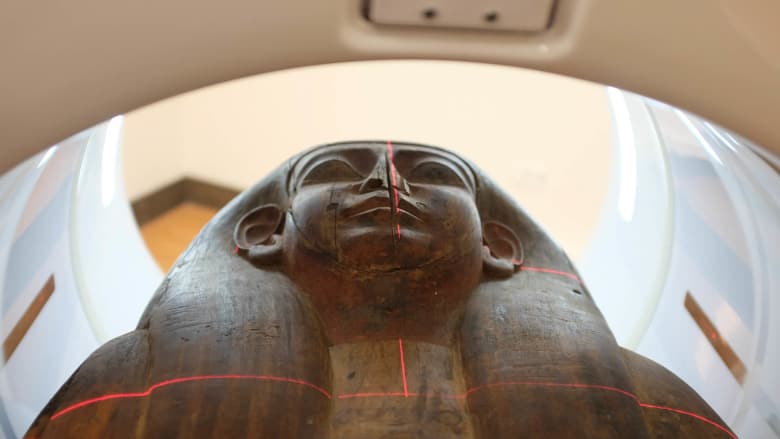
A newly-published study revealed secrets about the golden mummy, which has been preserved in the basement of the Egyptian Museum in downtown Cairo for more than a century.
It was recently moved for display at the museum’s halls.
The secrets were revealed in the scientific study, which was published in Frontiers in Medicine magazine on January 4, 2023, by Sahar Selim, Professor and Head of the Radiology Department at the Faculty of Medicine, Cairo University.
According to a statement by the Egyptian Ministry of Tourism: the mummy was found completely wrapped in linen in 1916.
It was found inside a cemetery from the Ptolemaic era (about 300 BC) in the city of Edfu, Aswan Governorate, where it was moved and preserved, at that time, in the basement of the Egyptian Museum in Tahrir Square, without examination for more than a century.
The mummy was examined for the first time in 2015.
Selim explained that the mummy of a boy who died at the age of 15 was embalmed with great perfection.
His brain was removed through the nostril and fillings and resin were placed inside the skull cavity.
The entrails were also removed through a small incision in the lower abdomen, the fillings and resin were placed inside the body, while the embalmers were keen to keep the heart, which was seen in x-rays, inside the chest cavity.
She added that the x-rays showed what was inside the wraps, where the mummy wore a golden mask, a vest made of cartonnage, and sandals made of fabric.
The two-dimensional and three-dimensional CT scans showed that there were about 49 amulets arranged in an ornate way in three columns between the folds of the linen rolls and inside the mummy’s cavity.
The rays also showed 21 different shapes of amulets, such as the eye of Horus, the scarab, the amulet of the rising sun, the placenta, the knot of Isis, the two feathers, and others.
According to the study, thirty of the amulets discovered inside the mummy were made of gold, while the rest of the amulets were made of stones or faience, in addition to an amulet in the form of a tongue of gold placed inside the mouth of the deceased so that he could speak in the other world.
There is a two-finger amulet at the bottom of the torso to protect the embalming hole and another large gold scarab heart amulet is inside a cavity.
A two-finger amulet could be seen at the bottom of the torso to protect the embalming hole, and another large gold scarab heart amulet inside the cavity of mummy’s chest, which has been reproduced using 3D printing.
Selim said that the study revealed the face of the mummy for the first time using CT scan technology.
The study provided a unique opportunity to discover the secrets of mummification without removing the scrolls.
Sabah Abdel Razek, director general of the Egyptian Museum, said the study shed light on social life in ancient Egypt thousands of years ago.
The study gave a deep understanding of their beliefs and funeral rituals, and their technical prowess in mummification and in crafting amulets, making masks, and decorations, she added.
The study also indicated the appreciation of the ancient Egyptians for children, as the mummy which belonged to a child enjoyed distinguished funerary rituals.
The mummification demonstrated the high social status of the mummy’s owner, as he was a boy who enjoyed high-ranking funeral rites, in addition to being in good health, as he had healthy teeth and bones and had no signs of disease or symptoms of malnutrition, Abdel Razek added.
The use of modern technology and techniques in 3D medical imaging helped provide a valuable view of the mummy, which supported the decision of the Egyptian Museum to move the mummy from the basement of the museum for display in its exhibition halls, where it was dubbed “The Golden Boy Mummy”.
CT scan images have been displayed next to the mummy to contribute to giving visitors a unique experience.




